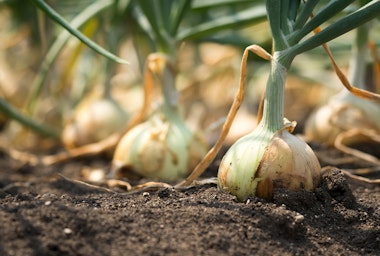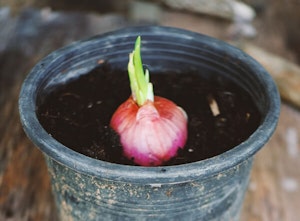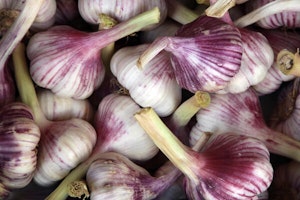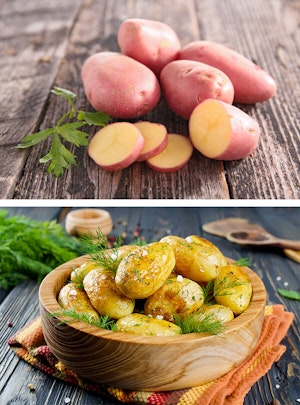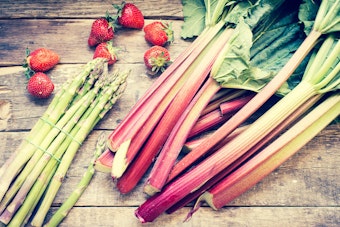Edible Bulbs, Tubers & Crowns
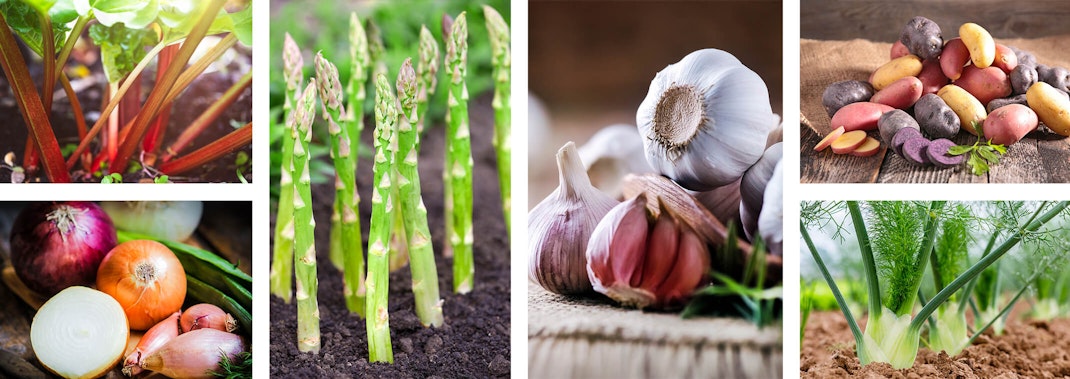
Grow Your Own Edible Bulbs, Tubers & Crowns
Looking to add flavor and variety to your garden? You can grow a range of tasty crops like onions, shallots, garlic, potatoes, fennel, asparagus, and rhubarb. These seasonal bulbs, tubers, and crowns can be planted directly in the ground or in container gardens.
You can even plant edible bulbs alongside decorative flowers like pansies or violas, which act as a cover crop until your bulbs begin to sprout.
To confirm availability, contact your nearest SummerWinds Nursery location, as selection varies seasonally and daily by location.
Nothing More Powerful Than An Onion
Each onion variety offers unique flavors, textures, and colors, but they are interchangeable in most recipes. When cooked, all types behave similarly, making them versatile ingredients.
Our seasonal selection typically includes the following:
-
Red Onions: With their striking purple-red skin and white to red flesh, red onions offer a sharp, slightly spicy flavor with a touch of sweetness. They’re excellent raw in salads, sandwiches, and as a garnish for tacos. Their vibrant color also enhances the visual appeal of dishes.
-
Yellow Onions: The most commonly used onion, yellow onions have a golden-brown outer skin and white to pale yellow flesh. Raw, they have a pungent taste, but cooking brings out their sweet, savory flavor. A staple in soups, stews, and sautés, yellow onions are versatile. We also carry a super-sweet yellow variety.
-
White Onions: These onions have a crisp white skin and a mild, slightly sweet flavor. More delicate than yellow onions, they’re often used in Mexican cuisine and other dishes where a milder onion is desired. They work well in fresh salsas, salads, and sandwiches, and are great for pickling due to their mildness.
Shall We Plant Shallots?
Shallots are a must-have in any kitchen. They’re popular in French cuisine for sauces like mignonette, and they also feature prominently in Asian dishes, often fried or used in curry pastes. Their flavor is milder than red onions but stronger than yellow, with a hint of garlic. Uses include frying thin slices for crispy toppings, mincing into vinaigrettes, and roasting alongside meats. They’re a key ingredient for the ultimate Thanksgiving green bean casserole!
Ahhh Garlic!
Garlic adds a bold, fresh flavor to countless dishes. Roast whole cloves, dry it for dressings and butters, or mince it as a base for sauces, casseroles, and soups. A kitchen essential for every home cook!
Some of our Favorite Varieties:
-
California Garlic: One of the most common garlic varieties in the United States, it’s often the softneck type used for mass production. California garlic has a mild to medium flavor and stores well, making it a staple in many kitchens.
-
Duganski Garlic: A hardneck garlic variety known for its rich, bold flavor. It has large, purple-striped bulbs and is popular for its robust, spicy heat, making it great for roasting or adding strong garlic flavor to dishes.
-
Elephant Garlic: Despite its name, it’s more closely related to leeks than true garlic. Elephant garlic produces massive cloves and has a much milder, almost sweet flavor, which makes it great for roasting or using raw in salads.
-
German Red Garlic: A hardneck type with deep red streaks on its bulb wrappers, this variety has a strong, rich flavor with a slightly hot bite. It’s favored in cold climates and produces large cloves that are easy to peel.
-
Krandasger Red Garlic: A rare hardneck variety known for its reddish-purple bulb wrappers and excellent storage capabilities. It has a bold, spicy flavor and performs well in cooler climates.
-
Music Garlic: A highly popular hardneck garlic variety, Music garlic has large, easy-to-peel cloves. It offers a strong but clean, sweet, and hot flavor, making it perfect for both cooking and medicinal uses.
-
Purple Glazer Garlic: A striking hardneck garlic with vibrant purple-striped bulbs. It has a smooth, mild flavor with a slight sweetness, making it ideal for raw dishes and salads or for when you want a less intense garlic note.
These varieties cover a spectrum of garlic flavors and uses, from mild to pungent, and are well-suited for different culinary applications.
Home-Grown Potatoes
While growing potatoes in the Valley of the Sun can present some challenges due to heat and soil conditions, it’s possible with the right techniques! Here are some specific tips to help you successfully grow potatoes in our desert climate:
1. Best Planting Time
Cooler Months: In the Valley, the ideal time to plant potatoes is late winter or early spring (January to early March) or in late fall (September to October) to avoid the extreme summer heat. Potatoes prefer cooler temperatures for tuber development, so planting when the temperatures are between 60°F and 70°F is optimal.
2. Soil Preparation
- Loose, Well-Drained Soil: Potatoes need loose soil to develop properly, so it’s essential to amend the native soil with compost or organic matter to improve texture. This also enhances water retention while ensuring good drainage, which is critical for preventing rot.
- Raised Beds: If the native soil is too compact or poor quality, consider planting in raised beds filled with loose, nutrient-rich soil or potting mix. This allows you to control the soil quality and drainage better.
3. Protect from Heat
- Mulching: After planting the seed potatoes, cover them with a thick layer of mulch (straw or compost). Mulch helps to insulate the soil, keeping it cool and retaining moisture, which is essential in our desert climate.
- Shading: Once the temperatures start rising in late spring, provide some afternoon shade using shade cloth or plant them in a location that gets partial shade during the hottest part of the day. This can prevent the plants from overheating and helps tubers form properly.
4. Watering
- Deep, Consistent Watering: Potatoes need consistent moisture, especially during the tuber-forming stage. Water deeply and regularly but avoid waterlogging the soil. Drip irrigation or soaker hoses work well to provide even moisture without oversaturating the soil.
- Monitor Soil Moisture: In the hot desert climate, it’s important to regularly check soil moisture, ensuring the soil stays moist but not soggy. This will help prevent the potatoes from drying out or rotting.
5. Hilling
Add Soil or Mulch: As the potato plants grow, periodically add soil or mulch around the base of the plants to "hill" them. This protects the developing tubers from sunlight, which can cause them to turn green and become inedible. Hilling also helps keep the soil cool and promotes better yields.
6. Pest and Disease Control
- Pests: Keep an eye out for common pests like Colorado potato beetles, aphids, and flea beetles, which can be more prevalent in warm climates. Use organic pest control methods, such as insecticidal soaps, neem oil, or physical barriers like row covers.
- Avoiding Rot: Well-drained soil is essential to avoid rot, especially when temperatures fluctuate during the Valley's monsoon season. Ensure that the area doesn’t become waterlogged during unexpected rains.
7. Harvesting
- Early Harvests: You can harvest "new" potatoes when the plants begin to flower, usually 8-10 weeks after planting. These small, tender potatoes are great for immediate use.
- Final Harvest: For mature potatoes, wait until the foliage has completely died back. In the greater metro Phoenix area, you’ll want to harvest before the extreme summer heat sets in to avoid damage to the tubers.
8. Container Gardening
Grow in Containers: Growing potatoes in large containers or grow bags can be a good option in Phoenix. Containers provide better control over soil temperature and moisture, and you can move them into the shade as temperatures rise. Use a well-draining potting mix, and follow the same planting and hilling process as you would in the ground.
By adjusting your planting schedule, choosing the right varieties, and managing soil and water carefully, you can grow healthy, productive potato plants even in our challenging desert climate.
Want More?
To learn more about growing potatoes, check out this YouTube video, or this article, from Growing in the Garden.
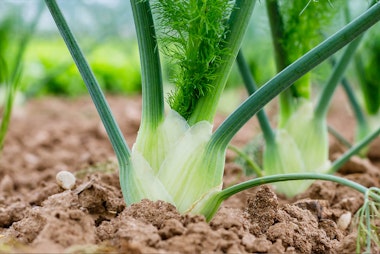
Bulb Fennel
With its mild, anise-like flavor, bulb fennel is a delicious addition to your garden. Not only can you enjoy the bulbs, but the seeds are also great for culinary use.
Asparagus Crowns
To successfully grow asparagus in the Valley, it requires careful planning. Here are key factors to consider:
- Planting Time: Plant asparagus crowns in late fall or early winter (November to February) when the temperatures are cooler.
- Soil Preparation: Asparagus prefers well-draining soil, so amend the soil with compost and organic matter to retain moisture and provide nutrients.
- Watering: Regular, deep watering is crucial, especially during the hot summer months. Mulching around the plants will help conserve moisture and keep the soil cool.
- Shade in Summer: Asparagus will go dormant in the summer heat, so it’s helpful to provide some afternoon shade to protect it from intense sun exposure.
- Longevity: With proper care, an asparagus bed can produce for 10-20 years, but in our desert climate, you'll need to be vigilant about watering and shade during our hottest months.
Rhubarb
Rhubarb is more difficult to grow in the Valley due to its preference for cooler climates. It typically struggles with the desert heat. Below are some things to keep in mind, if you'd like to grow rhubarb:
- Temperature Sensitivity: Rhubarb thrives in cooler temperatures, and the Valley's extreme summer heat is not ideal. It can suffer if exposed to temperatures over 90°F for extended periods.
- Best Strategy: In the Valley, rhubarb is often treated as an annual rather than a perennial. You can plant it in the fall or early spring and enjoy the harvest before the intense summer heat sets in.
- Growing in Containers: Some gardeners in greater Metro Phoenix area have had success growing rhubarb in containers, where they can move it to a cooler, shaded area during the summer.
For summer plant gardening tips and ways you can protect plants from our extreme summer heat, click the button below:
Heatwave Plant ProtectionTo learn more about growing these edible bulbs, tubes and crowns in your Tasty Garden, speak with one of our Trusted Garden Advisors!
Contact your favorite SummerWinds Nursery location, to confirm availability.

